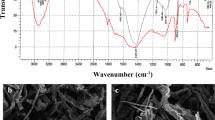Abstract
A study was undertaken to determined if a suitable biosorbent could be found for removal of nickel at low concentrations (< 20 parts per million [ppm]) from a chemically complex wastewater effluent generated by electroplating operations. Algae and cyanobacteria were chosen as candidate biosorbent materials because they are easy to grow and they have the ability to withstand processing into biosorbent materials. Several species were screened for nickel-biosorption capacity initially, and three species of cyanobacteria were selected for further study based on their performance in the sco** tests. When compared to live controls, autoclaving improved the binding capacities of all three species, but usually biosorption data from experiments with live cells were more consistent. None of the three species was able to bind nickel efficiently in actual effluent samples. Further experimentation indicated that sodium ions, which were present in high concentrations in the effluent, were interfering with the ability of the cells to bind nickel. Adsorption isotherm plots for biosorption of nickel by two species ofAnabaena in NiCl2-deionized water solutions were prepared.
Similar content being viewed by others
References
Benemann, J. R. and Wilde, E. W. (1991),Literature review on the use of bioaccumulation for heavy metal removal and recovery, vol. 2, Westinghouse Savannah River Co. Report No. WSRC-TR-90-175-VOL. 2.
Chan, S. S., Chow, H., and Wong, M. H. (1991),Biomed. Environ. Sci. 4(3), 250.
Wong, M. H. and Pak, D. C. H. (1992),Biomed. Environ. Sci. 5(2), 99.
Aksu, Z., Sag, Y., and Kutsal, T. (1992),Environ. Technol. 13(6), 579.
Aksu, Z. and Kutsal, T. (1990),Environ. Technol. 11, 979.
Aksu, Z. and Kutsal, T. (1991),J. Chem. Tech. Biotechnol. 52, 109.
Garnham, G. W., Codd, G. A., and Gadd, G. M. Garnham, G. W., Codd, G. A., and Gadd, G. M. (1992),Environ. Sci. Technol. 26(9), 1764.
Mahan, C. A., Majidi, V., and Holcombe, J. A. (1989),Anal. Chem. 61(6), 624.
Gardea-Torresdey, J. L., Becker-Hapak, M. K., Hosea, J. M., and Darnall, D. W. (1990),Environ. Sci. Technol. 24, 1372.
Mann, H., Fyfe, W. S., Kerrich, R., and Wiseman, M. (1989),Biorecovery 1(3), 155.
Wang, H.-K. and Wood, J. M. (1984),Environ. Sci. Technol. 18(2), 106.
Les, A. and Walker, R. W. (1984),Water, Air, Soil Pollut. (Netherlands) 23(2), 129.
Verma, S. K. and Singh, S. P. (1990),Curr. Microbiol. 21, 33.
Campbell, P. M. and Smith, G. D. (1986),Arch. Biochem. Biophys. 244, 470.
Peterson, H. G., Healey, F. P., and Wagemann, R. (1984),Can. J. Fish Aquat. Sci. 41, 974.
Shehata, F. H. A. and Whitton, B. A. (1982),Br. Phycol. J. 17, 5.
Singh, D. P. (1985),J. Gen. Appl. Microbiol. 31, 277.
Jeffers, T. H., Ferguson, C. R., and Bennett, P. G. (1991), Biosorption of metal contaminants using immobilized biomass: a laboratory study, Bureau of Mines (Washington, DC) Report No. BUMINES-RI-9340.
Darnall, D. W. (1986),Biosorption of heavy metal ions from industrial/mining waste waters (technical completion report), New Mexico Water Resources Research Institute (Las Cruces) Report No. WRRI-210.
Kratz, William A. and Myers, J. (1955),Am. J. Bot. 49, 282.
Starr, R. C. (1964),Am. J. Bot. 51, 1013.
Author information
Authors and Affiliations
Additional information
Managed by Martin Marietta Energy Systems, Inc., for the US Department of Energy under contract No. DEAC05-84OR21400.
This article has been authored by a contractor of the US Government under contract Mo. DE-AC05-84OR21400. Accordingly, the US Government retains a nonexclusive, royalty-free license to publish or reproduce the published form of this contribution, or allow others to do so, for US Government purposes.
Rights and permissions
About this article
Cite this article
Corder, S.L., Reeves, M. Biosorption of nickel in complex aqueous waste streams by cyanobacteria. Appl Biochem Biotechnol 45, 847–859 (1994). https://doi.org/10.1007/BF02941854
Issue Date:
DOI: https://doi.org/10.1007/BF02941854




